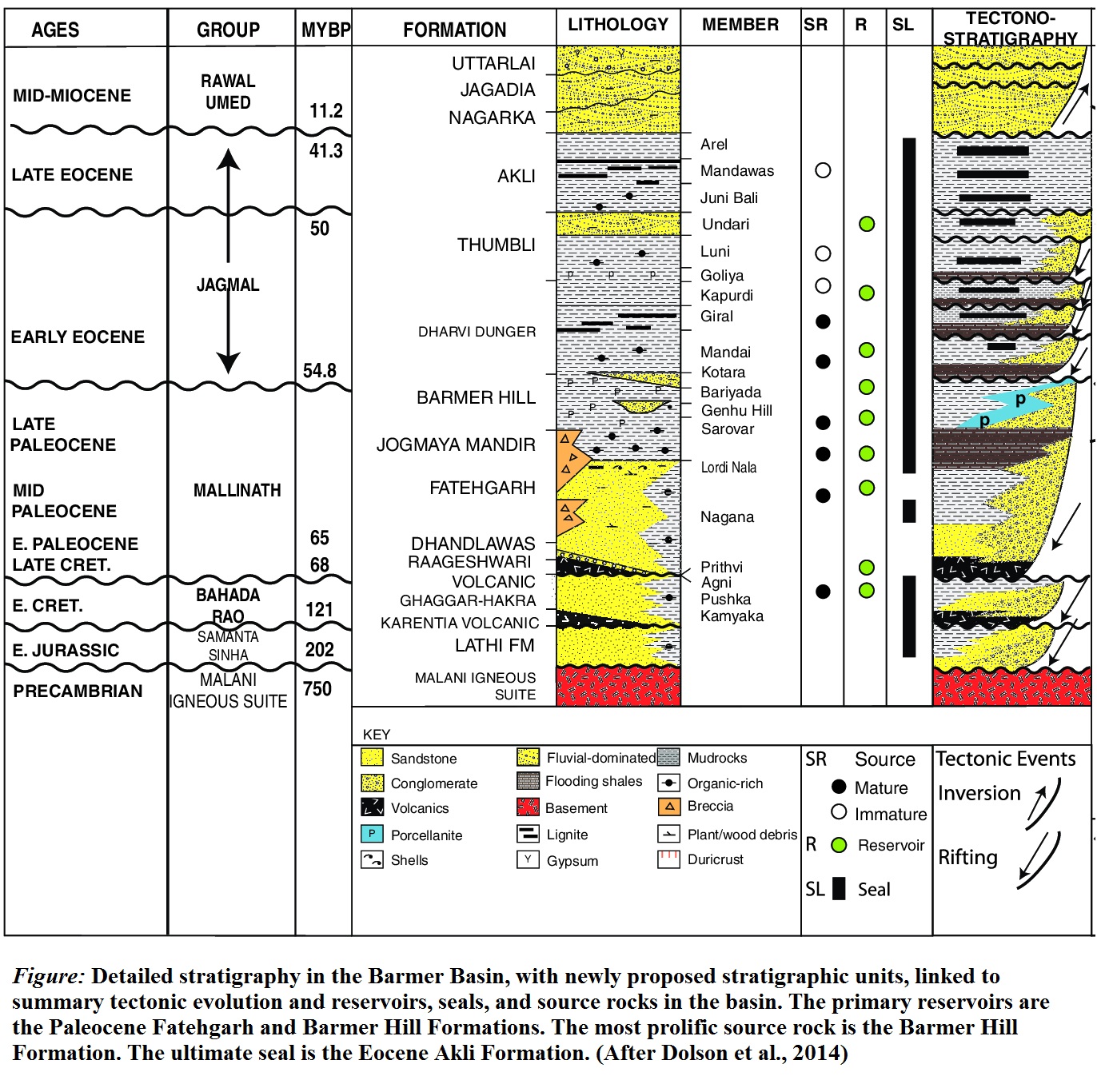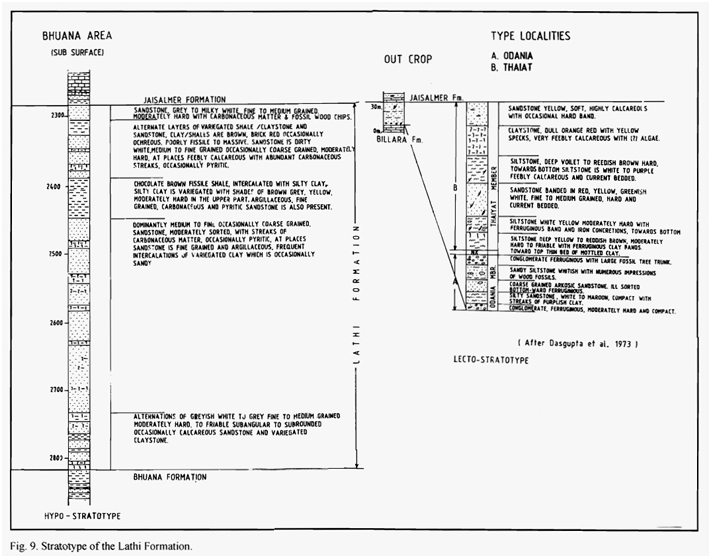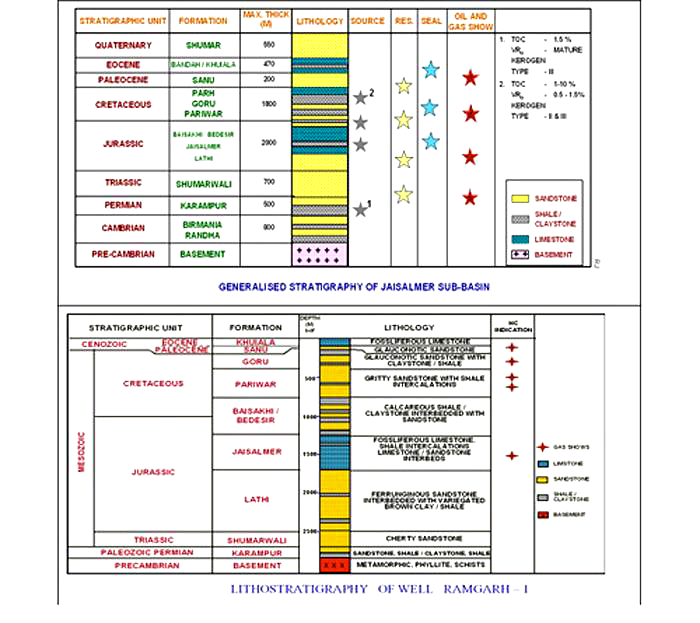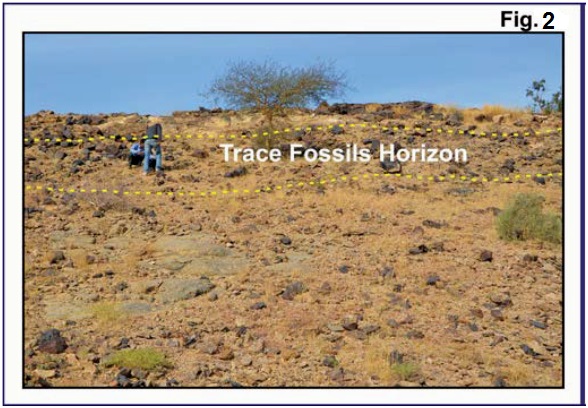Lathi Fm
Type Locality and Naming
OUTCROP. The formation is well exposed near Lathi, north west of Thaiat, Odaina and Akal. Type exposures at Odania and north west of Thaiat village. A full section of the formation is encountered in the subsurface in Bhuana well. [Original Publication: Swaminath, J., Krishnamurthy, J.G., Verma, K.K., and Chandak, G.J., 1959, General geology of Jaisalmer area, Rajasthan, ECAFE Symposium, Mineral Research and Development Series 10: 154-155]
SUBSURFACE: [Referred Publication: John Dolson, Stuart D. Burley, V.R. Sunder, V. Kothari, Bodapati Naidu, Nicholas P. Whiteley, Paul Farrimond, Andrew Taylor, Nicholas Direen, and B. Ananthakrishnan, 2015 : The Discovery of the Barmer Basin, Rajasthan, India, and its petroleum geology : AAPG Bulletin, 99 (issue 3, 1 Mar 2015), pp. 433-465; https://doi.org/10.1306/10021414045]
Synonyms: Oldham (1886) was first to name this as "Lathi beds" after the village Lathi. Swaminath et al. (1959) renamed it as the Lathi formation without assigning the type locality. Narayanan et al. (1961) gave distribution and referred only to a tube-well section for maximum thickness. Dasgupta (1975) subdivided this formation into two members, namely Odania and Thaiat and gave partly the vertical, exposed section at Thaiat.
Lithology and Thickness
Sandstone. It is mainly an arenaceous sequence of medium- to coarse-grained sandstone with interbeds of shale, claystone and occasional lignite. The exposed maximum thickness is 60 m as reported by Swaminath et al. (1959). Maximum thickness in subsurface is 600 m in the Shumarwali Talai area. The exposed formation has been subdivided into two members by Dasgupta (1975):
Odaina Member: It comprises the conglomerate bed at the base followed by white to maroon, sandy siltstone, and coarse-grained, dark, ferruginous sandstone, arkosic, coarse-grained, ill-sorted sandstone grading upwards to whitish grey, sandy siltstone with numerous wood fossils. At the top, it has another conglomerate bed with large fossil tree trunks associated with coarse-grained sandstone bands in the scarp section south of Bhojka. This member overlies the Bilara-equipment Formation in north and south east of Odania Village.
Thaiat Member: This member includes alternating sequence of siltstone, sandstone and claystone. Deep yellow to reddish brown, moderately hard to friable siltstone with ferruginous clay bands and iron concretions are exposed towards the base which is followed by sandstone in bands of red, yellow, greenish white, fine- to medium-grained, hard and current-bedded. The succeeding beds mainly comprise siltstone and claystone. Siltstones are deep violet to reddish brown, hard, occasionally feebly calcareous with algal matter. The top beds are represented by yellow, calcareous, soft sandstone with occasional hard bands. 'Kerboob' structure and "rib"-like structures are generally seen on weathered surface.
In the subsurface, the formation chiefly comprises sandstone shale and variegated claystone. The sandstone is greyish white to grey, fine- to medium-grained, moderately hard, at places argillaceous, poorly sorted and subangular to subrounded. The shale is grey, fissile, carbonaceous and at places pyritic. In upper part, frequent intercalcations of variegated clays and shales are common. Clays are grey, chocolate brown, brick red and yellow, moderately hard and compact.
[Figure 1: Stratotype of Lathi Formation, Mesozoic Lithostratigraphy of the Jaisalmer Basin, Rajasthan, Journal of the Paleontological Society of India, Vol. 51(2, )(after Singh N.P, 2006)]
[Figure 2: Detailed stratigraphy in the Barmer Basin, with newly proposed stratigraphic units, linked to summary tectonic evolution and reservoirs, seals and source rocks in the basin. The primary reservoirs are the Paleocene Fatehgarh Fm and Barmer Hill Fm. The most prolific source rock is the Barmer Hill Formation. The ultimate seal is the Eocene Akli Fm (Dolson et al., 2015)]
[Figure 3: Generalized and Subsurface Stratigraphy of Jaisalmer Basin (from dghindia.gov.in)]
Relationships and Distribution
Lower contact
In Barmer Basin, an unconformably overlies the Malani LIP Fm (Large Igneous Province) and Marwar Supergroup at outcrop, but has not yet been penetrated in wells in the basin.
In the northern outcrops in Jaisalmer Basin, the base of the formation is conglomerate with coarse, and ill-sorted sandstone which overlies the Bilara Fm equivalent formation of Proterozoic to Lower Cambrian age and at places, also the Birmania Fm. In other areas, it overlies the volcanic or granitic rocks southeast of Odania, indicating a big hiatus. However, in subsurface it conformably overlies the Bhuana Fm.
Upper contact
Major hiatus spanning Middle and Late Jurassic. In Barmer Basin, it is unconformably overlain by the Lower Cretaceous fluvial and lacustrine reservoirs of the newly defined Ghagga-Hakra Fm or with an intervening Karentia Volcanic Fm. In the Jaisalmer Basin, the formation has conformable and inter-tonguing relationship with overlying Jaisalmer Fm both in surface and subsurface.
GeoJSON
Fossils
In Jaisalmer Basin, the present paper here reports eight trace fossils from greyish yellow coarse- to medium-grained calcareous sandstone of Lathi Fm of Jaisalmer Basin. They are identified as Thalassinoides suevicus, Thalassinoides paradoxica, Ophiomorpha nodosa, Ophiomorpha borneensis, Palaeophycus heberti, Palaeophycus tubularis, Gyrocrote and Phycodes palmatum. All these trace fossils are well-preserved and abundant nature in Lower Odania Member of Lathi Fm of Jaisalmer Basin in Akal area (Fig. 3).
[Figure 5: Field photograph showing outcrops of Akal section of Lower Odania Member of Lathi Formation showing trace fossils bearing horizon: Discovery of Trace Fossils from Lower Odania Member of Lathi Formation of Jaisalmer Basin, Akal area, District-Jaisalmer, Western Rajasthan, India, (Parihar V.Singh et al. 2017)]
Age
Depositional setting
Additional Information




